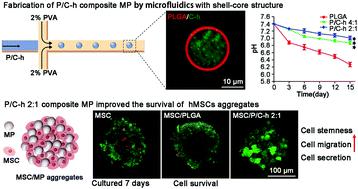当前位置:
X-MOL 学术
›
J. Mater. Chem. B
›
论文详情
Our official English website, www.x-mol.net, welcomes your feedback! (Note: you will need to create a separate account there.)
PLGA/chitosan–heparin composite microparticles prepared with microfluidics for the construction of hMSC aggregates
Journal of Materials Chemistry B ( IF 7 ) Pub Date : 2020-09-28 , DOI: 10.1039/d0tb01593h Min Ge 1, 2, 3, 4, 5 , Yaqi Sheng 1, 2, 3, 4, 5 , Shuyue Qi 1, 2, 3, 4, 5 , Lei Cao 1, 2, 3, 4, 5 , Yan Zhang 1, 2, 3, 4, 5 , Jun Yang 1, 2, 3, 4, 5
Journal of Materials Chemistry B ( IF 7 ) Pub Date : 2020-09-28 , DOI: 10.1039/d0tb01593h Min Ge 1, 2, 3, 4, 5 , Yaqi Sheng 1, 2, 3, 4, 5 , Shuyue Qi 1, 2, 3, 4, 5 , Lei Cao 1, 2, 3, 4, 5 , Yan Zhang 1, 2, 3, 4, 5 , Jun Yang 1, 2, 3, 4, 5
Affiliation

|
Incorporating poly(lactic-co-glycolic) acid (PLGA) microparticles into human mesenchymal stem cells (hMSC) aggregates has shown promising application prospects. However, the acidic degradation products and burst release of PLGA microparticles still need to be ameliorated. In this study, the PLGA/chitosan–heparin (P/C–h) composite microparticles were successfully fabricated by integrating the double emulsion and microfluidic technology through the precise manipulation of the emulsion composition and flow rate of the two-phase in a flow-focusing chip. The P/C–h microparticles were highly monodispersed with a diameter of 23.45 ± 0.25 μm and shell–core structure of the PLGA encapsulated C–h complex, which were suitable for the fabrication of hMSC aggregates. When the mass ratio of PLGA to the C–h complex was optimized to 2 : 1, the pH of the leach liquor of P/C–h microparticles remained neutral. Compared with those of PLGA microparticles, the cytotoxicity and the initial burst release (loaded FGF-2 and VEGF) were both significantly reduced in P/C–h microparticles. Furthermore, the survival, stemness, as well as secretion and migration abilities of cells in hMSC aggregates incorporating P/C–h microparticles were also enhanced. In summary, the P/C–h composite microparticles prepared by the droplet microfluidic technique support the optimal biological and functional profile of the hMSC aggregates, which may facilitate the clinical applications of MSC-based therapy.
中文翻译:

PLGA /壳聚糖-肝素复合微粒微流体制备用于构建hMSC聚集体
纳入聚(乳酸-共-乙醇酸(PLGA)微粒进入人间充质干细胞(hMSC)聚集体已显示出广阔的应用前景。但是,仍然需要改善PLGA微粒的酸性降解产物和爆炸释放。在这项研究中,PLGA /壳聚糖-肝素(P / C–h)复合微粒是通过将乳化液的组成和两相在流化床中的流速精确控制,通过将双重乳化液和微流体技术相结合而成功制备的。聚焦芯片。P / C-h微粒高度单分散,直径为23.45±0.25μm,具有PLGA封装的C-h复合物的壳核结构,适用于制造hMSC聚集体。当PLGA与C–h配合物的质量比优化为2:1时 P / C–h微粒的浸出液的pH值保持中性。与PLGA微粒相比,P / C–h微粒的细胞毒性和初始爆发释放(负载的FGF-2和VEGF)均显着降低。此外,掺入P / C-h微粒的hMSC聚集体中细胞的存活,干性以及分泌和迁移能力也得到了增强。总之,通过液滴微流技术制备的P / C-h复合微粒支持hMSC聚集体的最佳生物学和功能特性,这可能有助于基于MSC的疗法的临床应用。加入P / C–h微粒的hMSC聚集体中细胞的存活,干性以及分泌和迁移能力也得到了增强。总之,通过液滴微流技术制备的P / C-h复合微粒支持hMSC聚集体的最佳生物学和功能特性,这可能有助于基于MSC的疗法的临床应用。加入P / C–h微粒的hMSC聚集体中细胞的存活,干性以及分泌和迁移能力也得到了增强。总之,通过液滴微流技术制备的P / C-h复合微粒支持hMSC聚集体的最佳生物学和功能特性,这可能有助于基于MSC的疗法的临床应用。
更新日期:2020-10-11
中文翻译:

PLGA /壳聚糖-肝素复合微粒微流体制备用于构建hMSC聚集体
纳入聚(乳酸-共-乙醇酸(PLGA)微粒进入人间充质干细胞(hMSC)聚集体已显示出广阔的应用前景。但是,仍然需要改善PLGA微粒的酸性降解产物和爆炸释放。在这项研究中,PLGA /壳聚糖-肝素(P / C–h)复合微粒是通过将乳化液的组成和两相在流化床中的流速精确控制,通过将双重乳化液和微流体技术相结合而成功制备的。聚焦芯片。P / C-h微粒高度单分散,直径为23.45±0.25μm,具有PLGA封装的C-h复合物的壳核结构,适用于制造hMSC聚集体。当PLGA与C–h配合物的质量比优化为2:1时 P / C–h微粒的浸出液的pH值保持中性。与PLGA微粒相比,P / C–h微粒的细胞毒性和初始爆发释放(负载的FGF-2和VEGF)均显着降低。此外,掺入P / C-h微粒的hMSC聚集体中细胞的存活,干性以及分泌和迁移能力也得到了增强。总之,通过液滴微流技术制备的P / C-h复合微粒支持hMSC聚集体的最佳生物学和功能特性,这可能有助于基于MSC的疗法的临床应用。加入P / C–h微粒的hMSC聚集体中细胞的存活,干性以及分泌和迁移能力也得到了增强。总之,通过液滴微流技术制备的P / C-h复合微粒支持hMSC聚集体的最佳生物学和功能特性,这可能有助于基于MSC的疗法的临床应用。加入P / C–h微粒的hMSC聚集体中细胞的存活,干性以及分泌和迁移能力也得到了增强。总之,通过液滴微流技术制备的P / C-h复合微粒支持hMSC聚集体的最佳生物学和功能特性,这可能有助于基于MSC的疗法的临床应用。



























 京公网安备 11010802027423号
京公网安备 11010802027423号